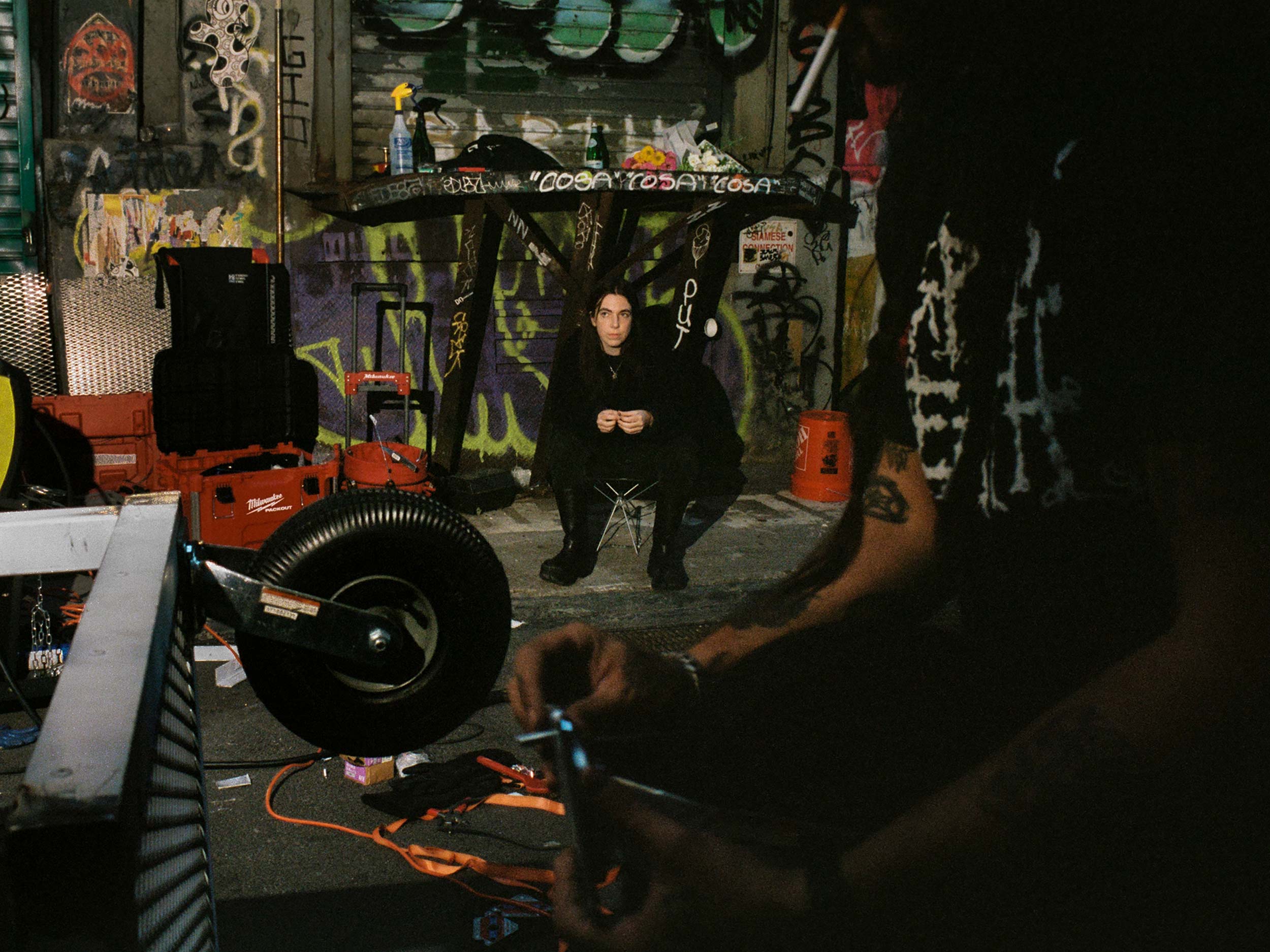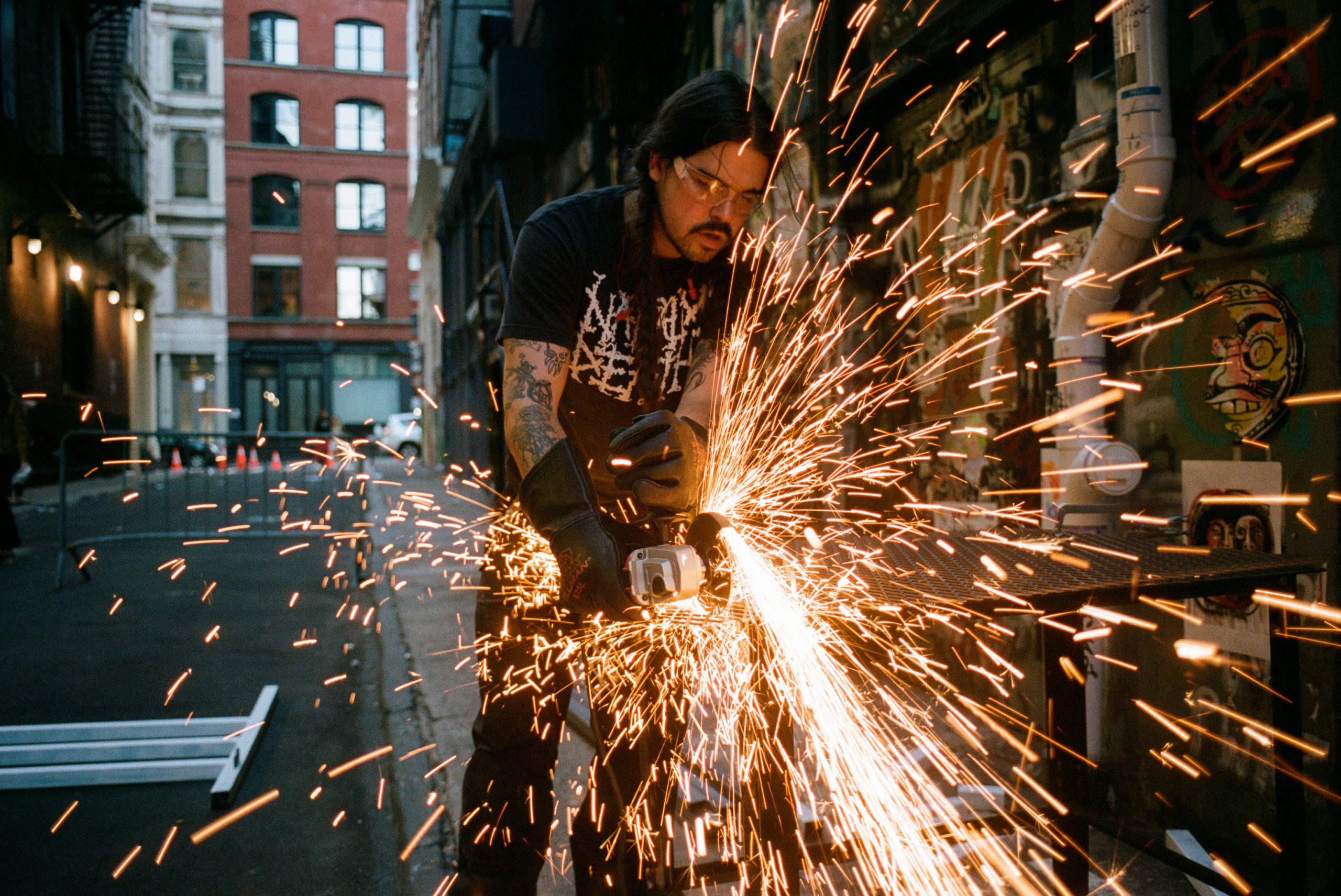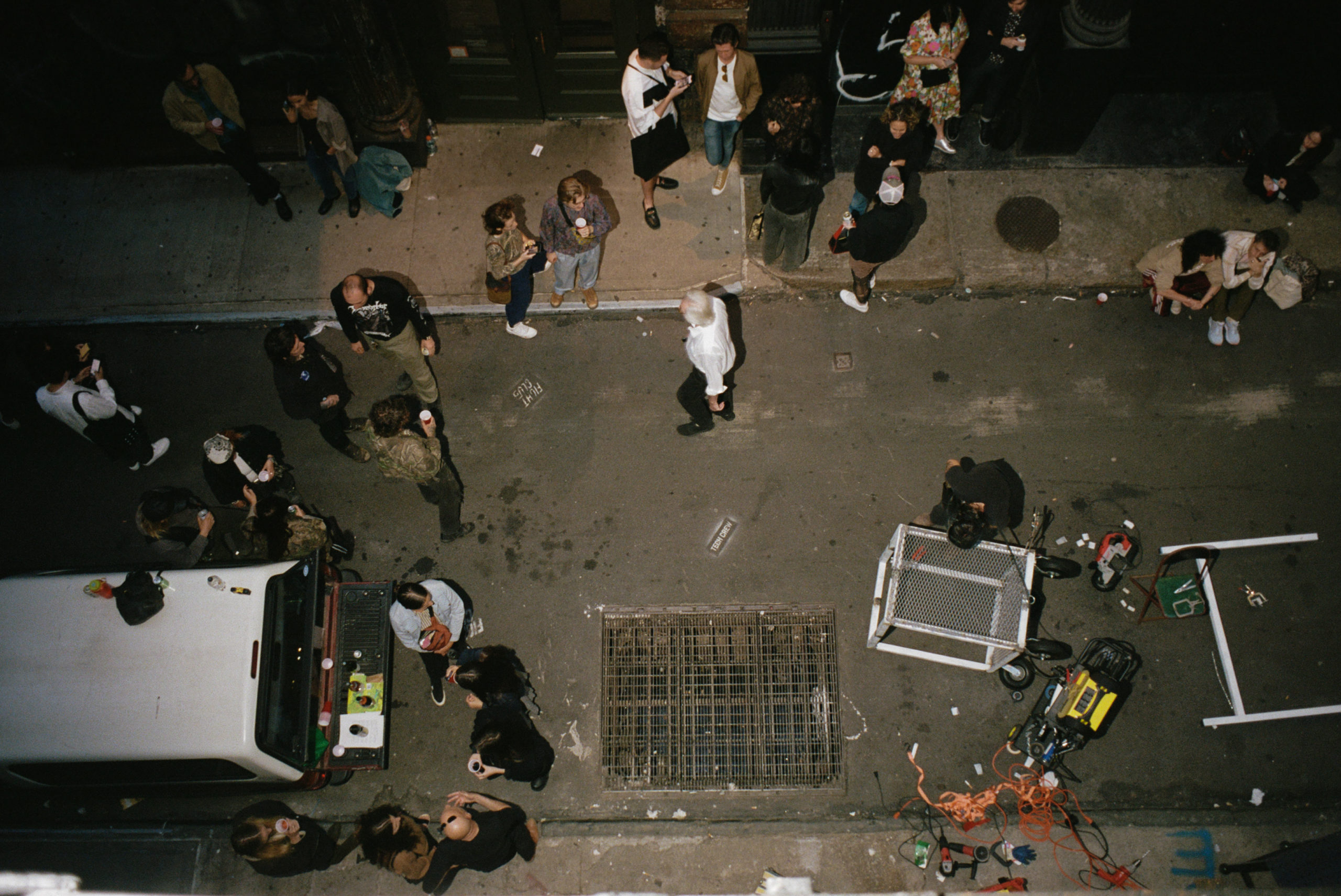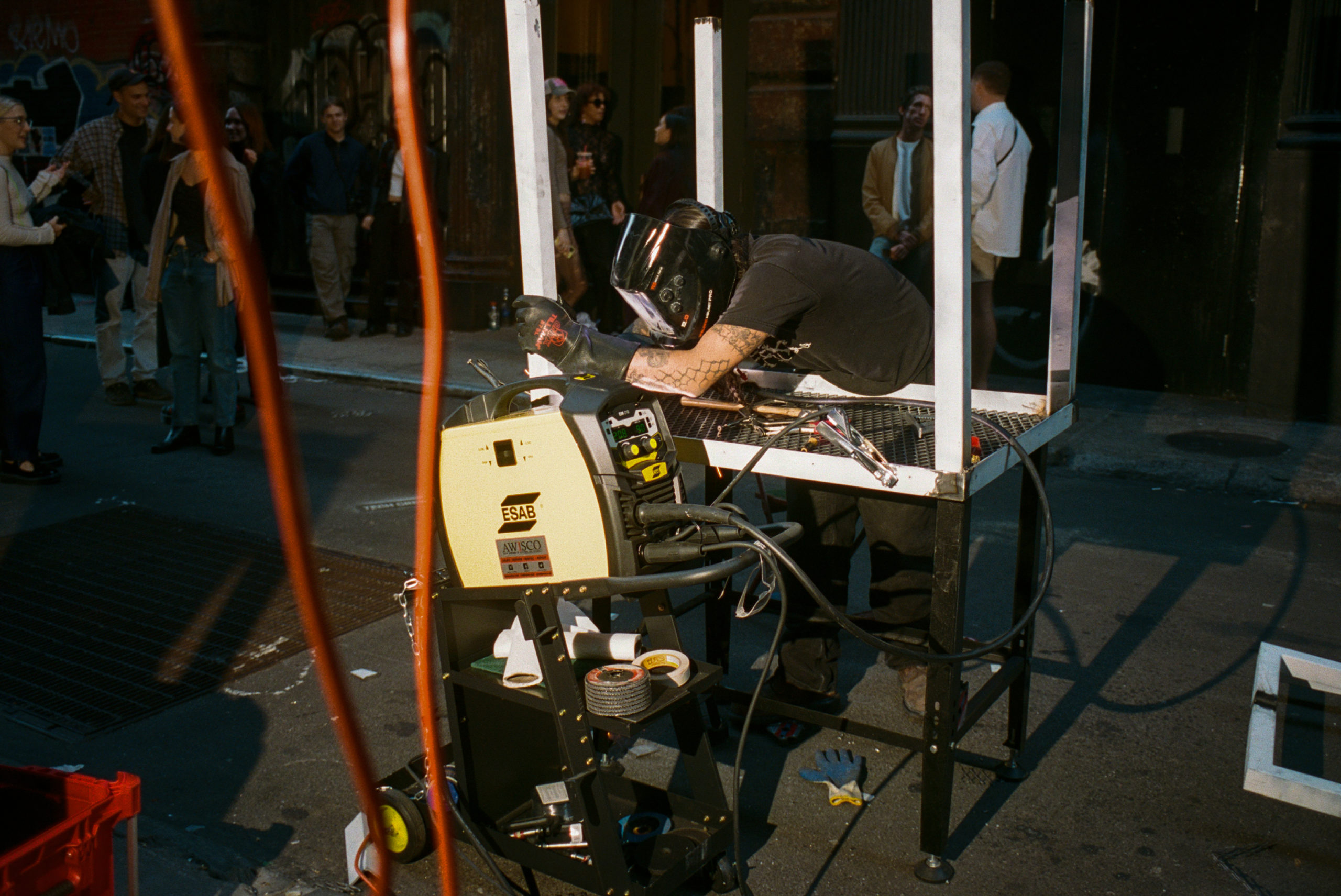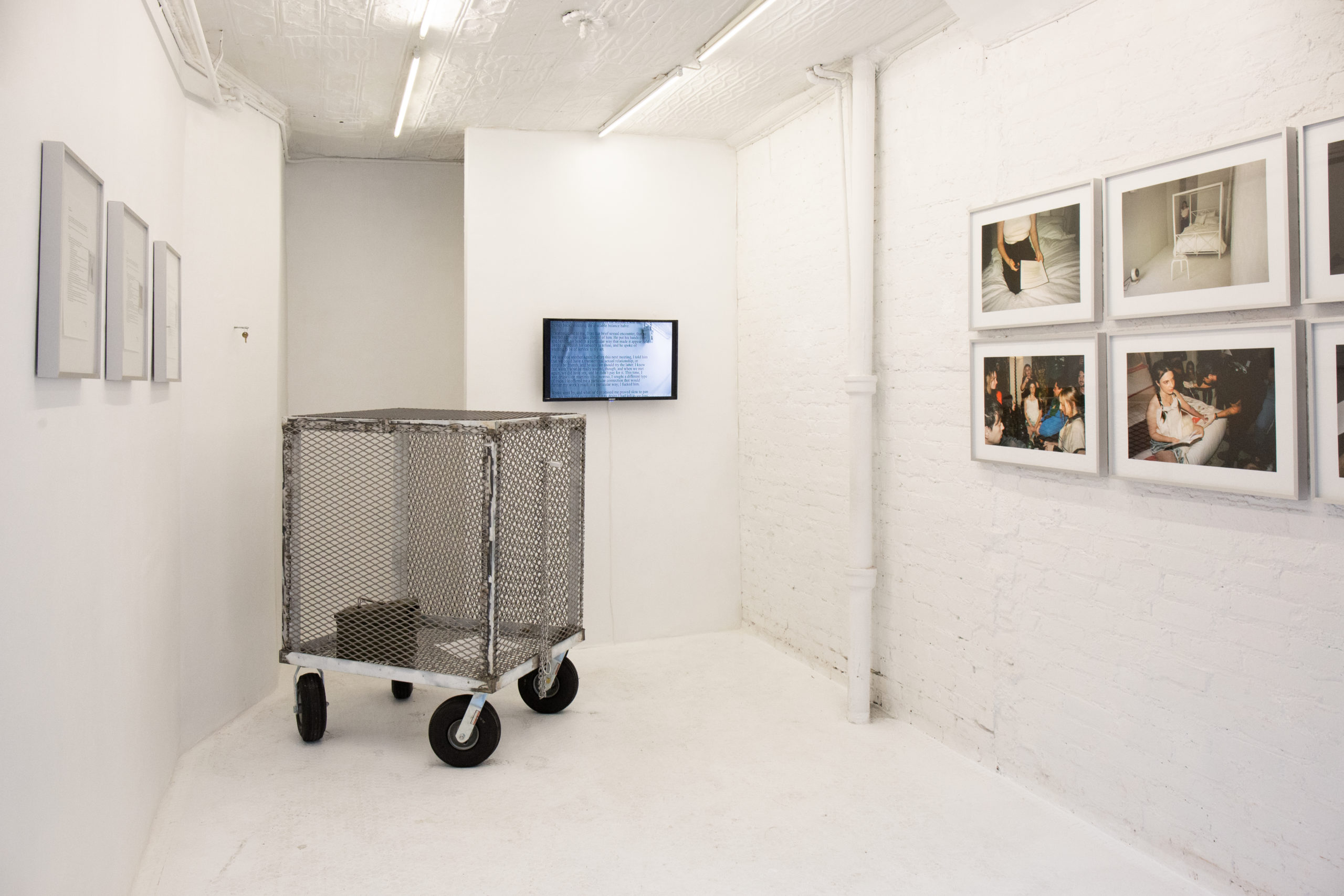In her new solo show, ‘Study 4: Collateral,’ the artist and auteur welds an ideology that reconsiders gendered assumptions
On September 24, I ventured downtown to the off-site opening of conceptual artist Sophia Giovannitti’s latest exhibition, Study 4: Collateral. Finding Giovannitti wasn’t easy. I managed to wander into the wrong building twice, before I was redirected to Cortlandt Alley: a backstreet just east of the corner of Broadway and Canal.
What might have typically been used as an alternate route, or a spot for an afternoon smoke break, had been transformed into something quite different. Below the rusting building facades, an old red Toyota Tacoma was parked with its hatch wide open. Spilled out onto the street were welding tools, a generator, ratchet straps, and a crowd of equally interesting-looking onlookers. Sparks flew dramatically into the air as a man, David Justice, worked intently, welding together scraps of metal into an ambiguous form. Giovannitti sat contently next to him. They both wore all black. She waved at me as I walked up, as if she already knew me or mistook me for someone else. I’d later find out that they’d been at work—better yet, performing—since earlier that morning.
This performance, allusively titled A Machine, took place in the shadowy alley behind PPOW. Upstairs and off Broadway, her newest short film, A Monopoly on Violence, premiered inside a stark viewing room. The film follows Giovannitti and her boyfriend, the welder I’d seen earlier, in upstate New York. In the film, Justice takes Giovannitti out into the woodlands by way of a four wheeler. Far removed from civilization, he teaches Giovannitti the basics of firearms, and together they load a collection of guns with live ammunition and practice firing at wooden targets. All the while, Giovannitti’s voice eloquently narrates a monologue. With perplexing ease, she examines the commodification of violence and the dynamics of power; she openly philosophizes on ethics and desire, while anecdotally discussing her own relationship. On this one wall, we watch gunpowder ignite and wood splinter—on another adjacent wall, a live surveillance video feed displays an aerial view of Cortlandt Alley, where sparks continue to fly.
The live feed and short film created an arresting juxtaposition. While metal ignited and pieces of wood were shattered by bullets on screen, something unknown was being built, also by way of burning metal, just a stone’s throw away. The film and performance were dually exhibited as an expansion on the themes Giovannitti had been examining throughout her career: surveillance, labor, violence, desire, faith, and the autonomy of meaning under the reign of capitalism. In one way or another, she proves (to me, at least) that the gun is not the harmful mechanism in this very case. Giovannitti captures what’s typically considered “violence” without being objectively “violent,” which is in accordance with “violating”; it’s to see something as it never sees itself—to reframe it, essentially. She sublimates the gun and does the same to herself—turning herself into an object, through film, that can be symbolically possessed. “The mediums that I’ve been using, like film, are me experimenting with different ways of making certain concepts legible or collectible,” Giovannitti told me. Watching her and Justice shoot the guns reminded me of a feeling described by Susan Sontag, in reference to photography: We participate in a cathartic exploration of their “mortality, vulnerability, and mutability.”
“It was our first experience working together,” Giovannitti says. “I think that making art with people you love is so romantic. What the film showed was Dave’s property and Dave’s guns and Dave’s personhood. It was very true to life in a very intimate sense—it was about him.”
The film ended and I proceeded back to Cortlandt Alley. The anonymous object continued to take form while Giovannitti sat there, perched, continuing to greet guests and those passing by. What does it mean to transgress, from the one shooting the gun to the one sitting aside? While Justice welds, Giovannitti is observing, commenting, and exposing the nature of the craft. “I’m interested in gendered power dynamics in heterosexual, hegemonic relationships,” Giovannitti explained. This was in accordance with Robert Morris’s 1964 performance piece, Site, performed with visual artist Carol Schneeman, where she emulated the pose and persona of Edouard Manet’s famous 1863 painting Olympia while Morris manipulated planks of wood to reveal and conceal her in plain sight. A Machine sentimentally subverts and corporealizes Site’s essence—it reconsiders the prescriptive, gendered expectations of female artists—what it means to be immortalized as a muse and “do nothing” in the conception of art.
But here, Giovannitti is not the muse—she is the auteur posturing herself as the muse. Both A Machine and A Monopoly on Violence expand on what it means to retain information while exposing oneself; maybe this explains why I still could not figure out what was being built during my prolonged visit. I studied the tools closely, almost religiously, with a nebulous devotion, trying to uncover what, exactly, was being made.
Giovannitti constructs by deconstructing. She critiques and questions her own position. She is a welder of thought and ideology, and she neatly eviscerates commonplace, gendered assumptions by manipulating and contorting the ritualized process of disseminating information and narrative. My writing will not be a key to understanding her body of work—that in itself is a lived experience, one that can’t be read. Her work is daunting: laden with personal anecdotes and punctuated by philosophical inquiry and chock-full of discourse on the aesthetics of exchange—things I wouldn’t say the average person is well-versed in, but constantly unconsciously participates in. “I intentionally try to resist singular readings of my work, in either an explicitly feminist or capitalist lens,” Giovannitti explains. But her conceptual art is just as tactile as it is cerebral; her work cascades into itself. “Everything gets absorbed into the concept behind the work,” Giovannitti explained. “The concept finds its way into the relationship with the gallerist, the relationship with the journalist, the relationship with the photographer, and the people coming in to see the work.” It’s meant to be experienced in an interdependent manner.
I surrendered to that experience at the opening. and left, two hours later, still questioning what exactly was being built. But that is no slight to the artist—if anything, quite the opposite. It is vital to participate in the confusion, the hyperawareness, the compulsivity to comprehend what she is getting at. It is through this longing to know, that an unorthodox relationship and meaningful transaction unfolds—both the artist and the viewer experience an opaque, yet symbiotic understanding of one another and the power dynamics at play.
The denouement of my thought process coincided with my interview with Giovannitti, which happened the following week. I met her at DUPLEX where Study 4: Collateral is on display. I perused the gallery: paraphernalia and mementos from past shows, framed and hung on the walls in the forms of NDAs, audio recordings, a poetic-surveillance film, print photographs, and finally, the sculpture from Cortlandt Alley. There it was in its final form: a sort of cage with wheels.
Nearby, there was a photograph of Giovannitti standing next to a white canopy bed; an installment from her last show, Contract. In this photo, Giovannitti’s form is obstructed, almost disappearing behind the white bedposts and the opaque shadows in the barren room.
It was at that moment that I realized what the sculpture was. What was once a bed was disembodied and transformed into something quite different, or maybe the same.
Giovannitti and I spoke for over an hour that afternoon. It’s an uncanny and entirely humbling experience to interview someone who breaks down your very role in her art practice. Our eagerness to chat was mutual, and while the transcript will reveal a conversation about “lying” by omission, the gendered history of the “muse”, the semantics of desire, guns, reality television, and our respective backgrounds, I have chosen to not share it. There is much power to be found in negating, in leaving room for discovery.
That is the essence of Giovannitti’s work—to integrate and disclose the very cryptic and nuanced routes that information is processed, abstracted, and understood again—dissecting the capacity for an autonomy of meaning.
Study 4: Collateral is on view at DUPLEX until October 16, 2022. Giovannitti’s book Working Girl: On Selling Art and Selling Sex from Verso Books is available for pre-order, and will be out in May 2023.


